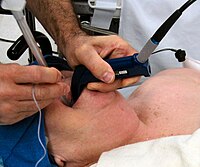
Photo from wikipedia
BackgroundProSeal (PLMA) and Supreme (SLMA) laryngeal mask airways are effective ventilator devices with distinctive designs that may require different anaesthetics for insertion. Sevoflurane induction provides acceptable conditions for laryngeal mask… Click to show full abstract
BackgroundProSeal (PLMA) and Supreme (SLMA) laryngeal mask airways are effective ventilator devices with distinctive designs that may require different anaesthetics for insertion. Sevoflurane induction provides acceptable conditions for laryngeal mask insertion, and remifentanil significantly decreases the minimum alveolar concentration of sevoflurane required for that insertion. The study aimed to evaluate the optimal end-tidal (ET) sevoflurane concentration for successful insertion of PLMA versus SLMA in patients receiving a remifentanil infusion without a neuromuscular blocking agent.MethodsAltogether, 45 patients ASA (American Society Anaesthesiologists) physical status I–II, aged 18–60 years were scheduled for elective ambulatory surgery. Exclusion criteria were a difficult airway, recent respiratory infection, reactive airway, obstructive sleep apnoea syndrome, gastric aspiration’s risk factors, pregnancy, and lactation. Patients were randomly allocated to receive the SLMA or the PLMA. Sevoflurane induction with co-administration of remifentanil was performed at an effect-site concentration of 4 ng mL− 1. ET50 was calculated with a modified Dixon’s up-and-down method (starting at 2.5% in steps of 0.5%). Predetermined sevoflurane concentration was kept constant during the 10 min before LMA insertion. Patient’s response to LMA insertion was classified as “movement” or “no movement”. Sevoflurane ET50 was determined as the midpoint concentration of all the independent pairs that manifested crossover from “movement” to “no movement”.ResultsThe ET50 sevoflurane concentration co-administered with remifentanil required for PLMA insertion was 1.20 ± 0.41% (95% confidence interval 0.76 to 1.63%). For SLMA insertion, it was 0.55 ± 0.38% (95% confidence interval 0.14 to 0.95%) (p = 0.019).ConclusionsThe end-tidal sevoflurane concentration with co-administered remifentanil required to allow insertion of the SLMA was 54% lower than that needed for inserting the PLMA.Trial registrationClinicaltrials.gov identifier: NCT03003377. Retrospectively registered. Date of registration: December 28, 2016.
Journal Title: BMC Anesthesiology
Year Published: 2020
Link to full text (if available)
Share on Social Media: Sign Up to like & get
recommendations!